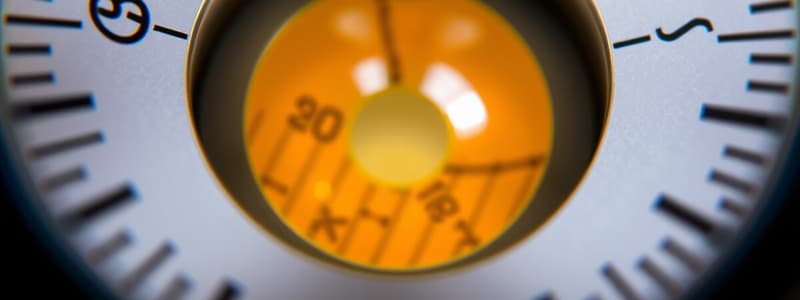Podcast
Questions and Answers
Define the measurements micrometer and nanometer.
Define the measurements micrometer and nanometer.
A micrometer (µm) is one-millionth of a meter (10^-6 meters) and a nanometer (nm) is one-billionth of a meter (10^-9 meters).
What are the two critical factors that influence your ability to see an object?
What are the two critical factors that influence your ability to see an object?
Resolution and contrast.
If you wish to increase the amount of light going into a microscope, what part would you adjust?
If you wish to increase the amount of light going into a microscope, what part would you adjust?
The iris diaphragm.
As light passes through a microscope, what is the last piece that light passes before reaching your eyes?
As light passes through a microscope, what is the last piece that light passes before reaching your eyes?
How is the total magnification of an object calculated?
How is the total magnification of an object calculated?
What is one limitation of fixing your sample?
What is one limitation of fixing your sample?
Phase-contrast microscopy provides what benefits to imaging?
Phase-contrast microscopy provides what benefits to imaging?
What is the distinguishing feature of dark field microscopy?
What is the distinguishing feature of dark field microscopy?
Unlike bright field microscopes, fluorescence microscopes illuminate samples through what spectrum?
Unlike bright field microscopes, fluorescence microscopes illuminate samples through what spectrum?
What is the primary difference between TEM and SEM?
What is the primary difference between TEM and SEM?
Gram staining is based on what basic principle?
Gram staining is based on what basic principle?
What is a key determinant in a bacteria being Gram-positive?
What is a key determinant in a bacteria being Gram-positive?
What is the purpose of heat fixing a sample?
What is the purpose of heat fixing a sample?
What is the primary purpose of a wet mount?
What is the primary purpose of a wet mount?
The acid-fast stain is most often used to identify what specific microorganism?
The acid-fast stain is most often used to identify what specific microorganism?
Flashcards are hidden until you start studying
Study Notes
Microscopy Measurements
- A micrometer (µm) is one-millionth of a meter (10⁻⁶ m).
- A nanometer (nm) equals one-billionth of a meter (10⁻⁹ m).
Viewing Objects
- Resolution is the minimum distance to distinguish two separate objects.
- Contrast refers to the light absorbance difference between objects, crucial for visibility.
- Poor contrast complicates viewing in low light conditions, such as distinguishing dark objects at night.
Microscope Light Control
- The iris diaphragm is adjusted to control light intensity reaching the sample and objective lens.
Light Path in Microscopy
- Light passing through a sample and the objective lens ultimately reaches the ocular lens (eyepiece) before entering the eye.
Total Magnification Calculation
- Total magnification = power of objective x power of eyepiece. For example, a 40x objective and a 10x eyepiece yield a total magnification of 400x.
Sample Fixation Limitations
- Fixation kills the sample, impeding the observation of motility and risking distortion of specimen shape and arrangement.
Phase-Contrast Microscopy Benefits
- Provides detailed images of live cells without staining by differentiating subtle differences between cells and their backgrounds.
Dark Field Microscopy Feature
- Utilizes angled light reflection for imaging, producing a dark background with a vividly lit specimen.
Fluorescence Microscopy Illumination
- Fluorescence microscopes use ultraviolet (UV) light to illuminate samples.
Electron Microscopy Differences
- Transmission Electron Microscopy (TEM): Electrons pass through the sample.
- Scanning Electron Microscopy (SEM): Electrons are reflected off the sample, creating a 3D model.
Gram Staining Principle
- Developed by Hans Christian Gram in 1884, it relies on bacteria's differing affinities for specific dyes during staining.
Gram-Positive Bacteria Characteristics
- Gram-positive bacteria possess a thick peptidoglycan layer, which retains the crystal violet dye, resulting in a purple color upon staining.
Purpose of Heat Fixing
- Heat fixing secures samples to the glass slide to prevent dislodging during staining and washing.
Purpose of Wet Mounts
- Wet mounts allow observation of live cells, their motility, and behavior in a controlled environment.
Acid-Fast Staining Application
- Primarily used to identify acid-fast bacteria, notably Mycobacterium tuberculosis, which resists decolorization.
Studying That Suits You
Use AI to generate personalized quizzes and flashcards to suit your learning preferences.




